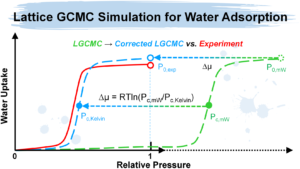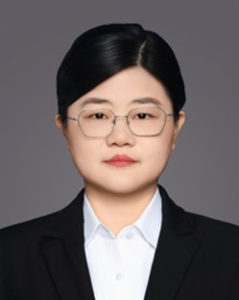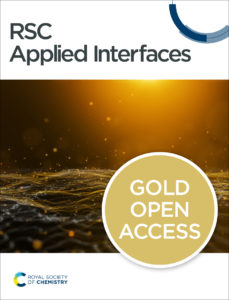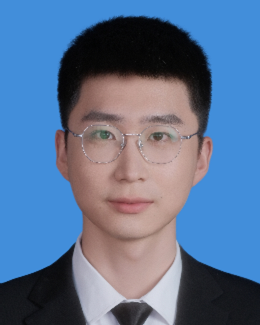
RSC Applied Interfaces publishes interdisciplinary work with an applied focus, which can be read for free here. To celebrate the excellent articles that have been published so far in our journal, we asked some of our authors to discuss their work in more detail.
In this post, we hear from the research team led by Associate Professor Song Li from Huazhong University of Science and Technology, as they provide insight into their recently published article entitled High-efficiency prediction of water adsorption performance of porous adsorbents by lattice grand canonical Monte Carlo molecular simulation.
Discover the full article here
 High-efficiency prediction of water adsorption performance of porous adsorbents by lattice grand canonical Monte Carlo molecular simulation
High-efficiency prediction of water adsorption performance of porous adsorbents by lattice grand canonical Monte Carlo molecular simulation
Zhilu Liu, Wei Li and Song Li
RSC Appl. Interfaces, 2025, 2, 230-242, DOI: 10.1039/D4LF00354C
Research Background
Water adsorption in porous adsorbents has come under the spotlight for its tremendous potential in numerous environment and energy-related applications, for example, adsorption water harvesting, desalination, adsorption heat pumps and chillers. In recent years, fast-growing novel adsorbents, such as metal-organic frameworks (MOFs), show outstanding water adsorption performance. From an experimental perspective, due to the large number of types and quantities of water adsorbents, it is still extremely challenging to comprehensively test all existing adsorbents. From a computational perspective, a hard truth is that the grand canonical Monte Carlo (GCMC) molecular simulation requires an extremely long time to simulate water adsorption in adsorbents, up to tens of months of computational wall clock time on a single CPU core to yield results. The large-scale GCMC computational deployment to identify optimal water adsorbents can be very challenging due to its extremely high computation expense. Therefore, a suitable approach to rapidly and accurately simulate water adsorption isotherms of porous adsorbents on a large scale is still in urgent development.
Insights from the authors
Recently, our research team led by Associate Professor Song Li from Huazhong University of Science and Technology has made significant progress. We employed the lattice grand canonical Monte Carlo (LGCMC) molecular simulation method to predict the water adsorption isotherms of nanoporous adsorbents. Additionally, we put forward a universal correction strategy for water adsorption isotherms, thereby achieving highly efficient and accurate prediction of the water adsorption isotherms of adsorbents.

Figure 1. Schematic Diagram of Water Adsorption Isotherms of Adsorbents Simulated by LGCMC and Corrected LGCMC
In this work, we attempted to use LGCMC to accurately and rapidly simulate the water adsorption performance of adsorbents using a coarse-grained Molinero water (mW) model. Six typical MOFs were tested to verify the feasibility of LGCMC for efficiently simulating water adsorption isotherms. In the LGCMC, given the monatomic nature of the mW water model leading to different phase behaviors in nanoscale confinement, a remarkable discrepancy (especially the different step positions) in the primitive LGCMC-predicted isotherms compared with experiments was observed. Thus, a general correction strategy of water adsorption isotherm by tuning the saturation pressure was adopted. Eventually, the simulated water adsorption isotherms consistent with both experimental results and GCMC results were obtained by the correction strategy using LGCMC. It is worth highlighting that the simulation of water adsorption in adsorbents by LGCMC can be accomplished within a few hours, which yielded a significant acceleration of two to three orders of magnitude compared to conventional GCMC simulations. Therefore, the corrected LGCMC is a powerful tool to screen a huge number of adsorbents to facilitate the discovery of potential adsorbents for water adsorption-related applications.
Meet the authors
|
Zhilu Liu, the first author of this paper, is a PhD candidate at the School of Energy and Power Engineering, Huazhong University of Science and Technology, under the supervision of Associate Professor Song Li. His research focuses on the high-throughput computational screening and performance evaluation of nanoporous adsorbents for various adsorption applications. By skillfully integrating a diverse set of advanced techniques such as molecular simulation, numerical simulation, data mining and machine learning, he can screen high-performing adsorbents for adsorption applications and reveal the potential structure-performance relationships between adsorbents and their performance. He has published 23 papers in SCI-indexed journals, among which 12 are as the first or co-first author, with an H-index of 10. He has also publicly disclosed and been authorized 10 invention patents. |
 Wei Li Wei Li
Dr Wei Li is an Associate Professor in the Energy & Electricity Research Center at Jinan University, Zhuhai, China. He received PhD in New Energy Science and Engineering from Huazhong University of Science and Technology. His current research interests are developing and evaluating novel materials, and exploring their heat and mass conversation in adsorption heat pumps, formaldehyde capture, and gas separation. |
 Song Li Song Li
Dr Song Li is currently Associate Professor of Department of New Energy and Science, School of Energy and Power Engineering at Huazhong University of Science and Technology (HUST), Wuhan, China. She obtained her PhD in Chemical Engineering from Vanderbilt University at USA in 2014, followed by a postdoctoral study in Prof. Randall Snurr Group of Northwestern University. Her research interests include the use of metal-organic frameworks in energy and environmental application by molecular simulation, machine learning, thermodynamics and experimental techniques.
|
 RSC Applied Interfaces is a dedicated, interdisciplinary reference journal for cutting-edge research on the applications of surfaces and interfaces. In addition to the applied focus, work considered for publication in RSC Applied Interfaces is expected to be highly original and of top quality. The journal seeks to report major scientific advances beyond the state of the art, at the cutting edge of this interdisciplinary field.
RSC Applied Interfaces is a dedicated, interdisciplinary reference journal for cutting-edge research on the applications of surfaces and interfaces. In addition to the applied focus, work considered for publication in RSC Applied Interfaces is expected to be highly original and of top quality. The journal seeks to report major scientific advances beyond the state of the art, at the cutting edge of this interdisciplinary field.


 Zhilu Liu
Zhilu Liu